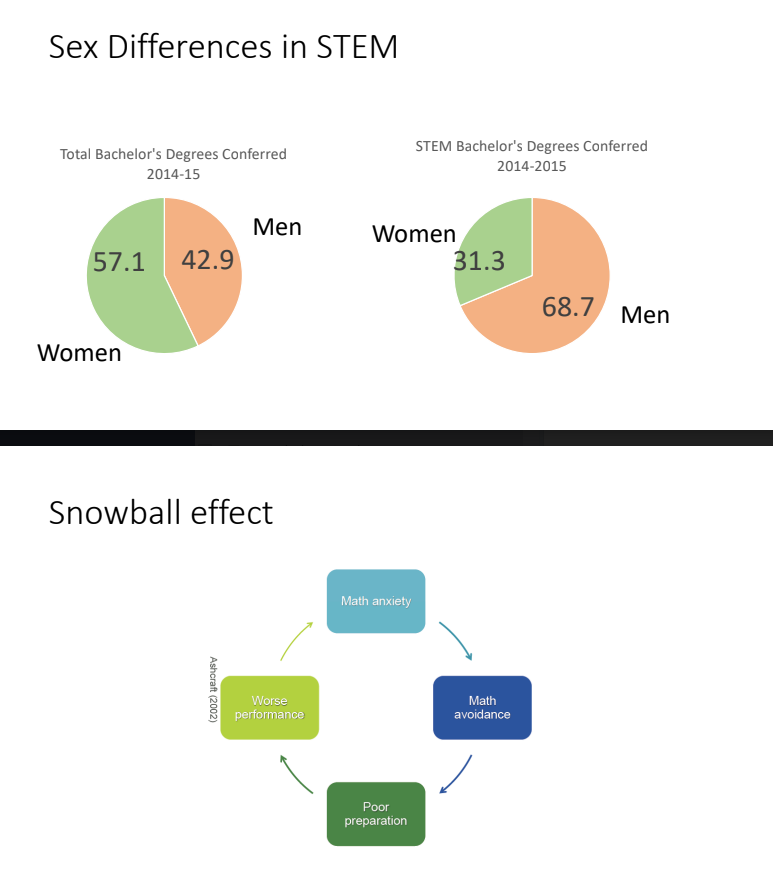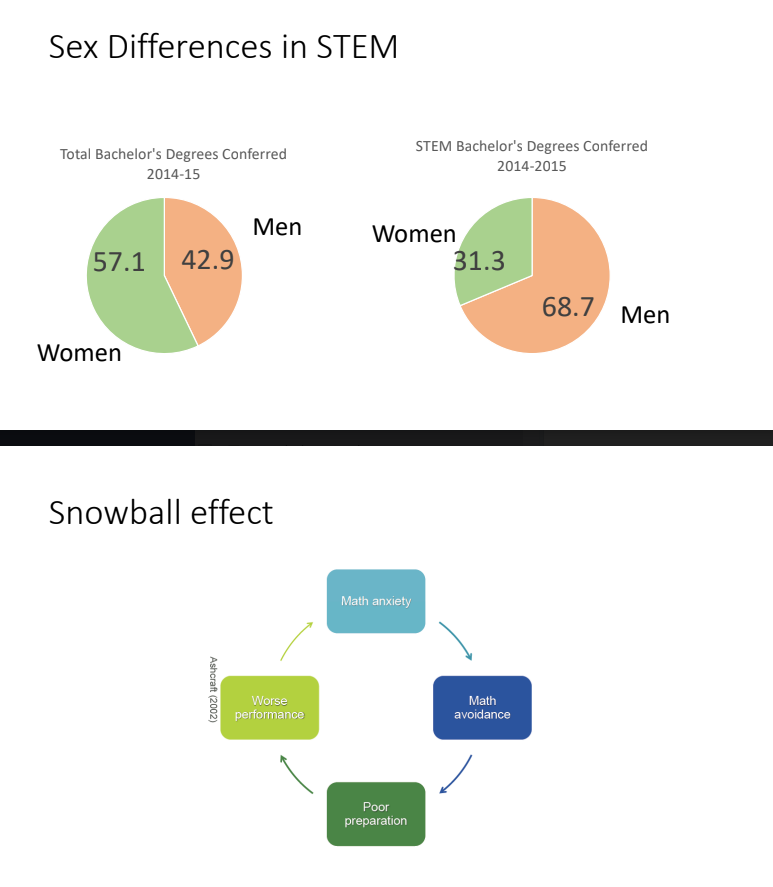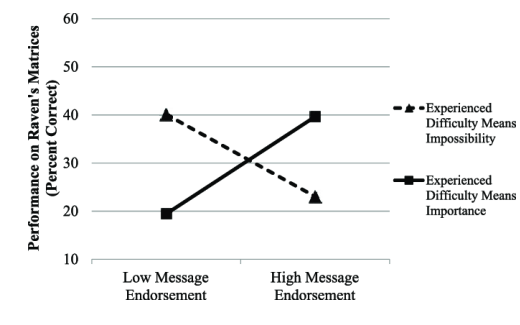Psych 356 (6): Math, Anxiety, and Stereotype Threat
0.0(0)
0.0(0)
Card Sorting
1/16
Earn XP
Description and Tags
Study Analytics
Name | Mastery | Learn | Test | Matching | Spaced |
|---|
No study sessions yet.
17 Terms
1
New cards
stereotype threat
“socially premised psychological threat that arises
when one is in a situation or doing something for which a negative
stereotype about one's group applies”
when one is in a situation or doing something for which a negative
stereotype about one's group applies”
2
New cards
math anxiety and stereotype threat similarity
- distracting thoughts
- affecting WM/attention capacity "leftover" for task
- both lead to avoidance
- affecting WM/attention capacity "leftover" for task
- both lead to avoidance
3
New cards
math anxiety
A fear or dread associated with mathematics
• Related to but distinct from trait anxiety and test anxiety
• ~17% of population
• Related to impaired math performance, achievement, & persistence
• Disproportionally affects females
Used to think it mostly developed in adolescence
• Now we know even first graders
• When doing math, even young children show activation in amygdala (fear
center)
• Related to but distinct from trait anxiety and test anxiety
• ~17% of population
• Related to impaired math performance, achievement, & persistence
• Disproportionally affects females
Used to think it mostly developed in adolescence
• Now we know even first graders
• When doing math, even young children show activation in amygdala (fear
center)

4
New cards
dunlosky et al karpicke et al study strategies
- effective study strategies: self-testing, distributed study, interleaved practice, elaboration/self-exploration
- less effective: rereading, highlighting
- less effective: rereading, highlighting
5
New cards
math anxiety and study strategies - study
Sample:
• 293 University of Michigan Undergraduates
• All taken math course in last 12 months
• Mage=19.03, 36.2% male
• Materials
• Abbreviated Math Anxiety Scale (AMAS; Hopko et al.,
2003)
• Desirable Difficulties in Math Scale (home grown)
• Math Motivated Strategies for Learning Questionnaire
(Berger & Karabenick, 2011)
• I study math by testing myself with new math
problems or practice exams without looking at the
solution. [self-testing]
• When I study math, I mostly reread my notes.
[rereading]
results:
- less likely to do self-testing or interleaving if they have math anxiety
- Math anxious individuals tend to use less effective study strategies
more often
• They don’t seem to be avoiding studying math per se, but using more
superficial and less deep processing strategies
• Differences arise in relatively high skilled students
• 293 University of Michigan Undergraduates
• All taken math course in last 12 months
• Mage=19.03, 36.2% male
• Materials
• Abbreviated Math Anxiety Scale (AMAS; Hopko et al.,
2003)
• Desirable Difficulties in Math Scale (home grown)
• Math Motivated Strategies for Learning Questionnaire
(Berger & Karabenick, 2011)
• I study math by testing myself with new math
problems or practice exams without looking at the
solution. [self-testing]
• When I study math, I mostly reread my notes.
[rereading]
results:
- less likely to do self-testing or interleaving if they have math anxiety
- Math anxious individuals tend to use less effective study strategies
more often
• They don’t seem to be avoiding studying math per se, but using more
superficial and less deep processing strategies
• Differences arise in relatively high skilled students
6
New cards
causes of math anxiety
standard motivation theory: value (importance) and self-efficacy (can i do it)
- missing early skills -> compounds
- subtle cues in environment (math-anxious parents, math-anxious teachers, no representation)
- missing early skills -> compounds
- subtle cues in environment (math-anxious parents, math-anxious teachers, no representation)

7
New cards
claude steele - studies on stereotype threat
Verbal GRE
Students by race - Black + White students
Two conditions
1 = diagnostic “genuine test”
2 = non-diagnostic “psychological factors”
Experiment 1 & 2
Black students consistently performed worse in #1
White students consistently performed better in #1
Verbal fragment task
Stereotype threat condition: _ _ c e — race/mice
Self-doubt condition: f l _ _ _ — flunk/flash
Results
Black students more often chose race in #1
White students more often chose mice in #1
Students by race - Black + White students
Two conditions
1 = diagnostic “genuine test”
2 = non-diagnostic “psychological factors”
Experiment 1 & 2
Black students consistently performed worse in #1
White students consistently performed better in #1
Verbal fragment task
Stereotype threat condition: _ _ c e — race/mice
Self-doubt condition: f l _ _ _ — flunk/flash
Results
Black students more often chose race in #1
White students more often chose mice in #1
8
New cards
shih study - asian-female
Female Identity Salient Condition
• (b) whether they had a roommate, (c) whether their floors were coed or
single sex, (d) whether they preferred coed or single-sex floors, etc.
• Asian- identity-salient condition
• (a) whether their parents or grandparents spoke any languages other than
English, (b) what languages they knew, (c) what languages they spoke at
home, etc.
• Control condition
• (a) whether they lived on or off campus, (b) whether they used the university
telephone service.
took math test, filled out questionnaire
- repeated the same thing for Canadians
results:
US: female identity would do worse than control, but Asian identity would do better than control; Asian > control > female
Canada: control > Asian > female
• (b) whether they had a roommate, (c) whether their floors were coed or
single sex, (d) whether they preferred coed or single-sex floors, etc.
• Asian- identity-salient condition
• (a) whether their parents or grandparents spoke any languages other than
English, (b) what languages they knew, (c) what languages they spoke at
home, etc.
• Control condition
• (a) whether they lived on or off campus, (b) whether they used the university
telephone service.
took math test, filled out questionnaire
- repeated the same thing for Canadians
results:
US: female identity would do worse than control, but Asian identity would do better than control; Asian > control > female
Canada: control > Asian > female
9
New cards
stereotype threat - men at stanford
people who identify as "good at math" most affected by stereotype -worried because they identify with the subject
10
New cards
stereotype threat triggers
- Situations in which members of one’s group are underrepresented in a domain
• Situations in which physical objects suggest that members of one’s group do not belong in
- Situations in which members of one’s group are treated negatively (overtly or subtly)
• Situations in which members of one’s group are treated negatively (overtly or subtly
• Situations in which physical objects suggest that members of one’s group do not belong in
- Situations in which members of one’s group are treated negatively (overtly or subtly)
• Situations in which members of one’s group are treated negatively (overtly or subtly
11
New cards
reducing math anxiety and stereotype threat (1)
Math Anxiety: One-on-one tutoring, Expressive writing
Stereotype threat
• Explicitly teaching about stereotype threat
• Seeing successful examples of people like you
• Promoting the message that “difficult” means important, and that you are
learning, not that you can’t do it
Stereotype threat
• Explicitly teaching about stereotype threat
• Seeing successful examples of people like you
• Promoting the message that “difficult” means important, and that you are
learning, not that you can’t do it
12
New cards
tutoring and math anxiety
- lower fear response
- less math anxiety
reasons: encouraging feedback, no social pressure, no time pressures, no performance
- 2-sigma problem: almost 2stdev increase because tutoring
- less math anxiety
reasons: encouraging feedback, no social pressure, no time pressures, no performance
- 2-sigma problem: almost 2stdev increase because tutoring
13
New cards
expressive writing
reduced math anxiety for tasks with high WM demand
14
New cards
ways to reduce math anxiety (2)
• Celebrate Mistakes
• Create a classroom culture that normalizes struggles and celebrates
mistakes
• Communicate to students that you love mistakes and welcome them in
your class
• •Give work that encourages mistakes by keeping students at the edge of
their skills
• •Consider having students present incorrect solutions to the class and then
work as a team to find a correct answer
• Make sure students recognize that some math concepts/procedures are
hard for everyone and it takes time to learn
• Create a classroom culture that normalizes struggles and celebrates
mistakes
• Communicate to students that you love mistakes and welcome them in
your class
• •Give work that encourages mistakes by keeping students at the edge of
their skills
• •Consider having students present incorrect solutions to the class and then
work as a team to find a correct answer
• Make sure students recognize that some math concepts/procedures are
hard for everyone and it takes time to learn
15
New cards
"racially fair" test
telling people a test was racially fair worked, but only when a strong case was made
16
New cards
reframe difficulty - result
if people believe difficulty = important, they do better (vs impossible)

17
New cards
miyake et al
Tested whether self-affirmation would reduce effects of
stereotype threat for undergraduate women in a physics class
• In this study, all participants wrote an essay
• Affirmation condition: selected a set of values important to them from
a list and wrote about them- relationships with friends and family,
learning, etc)
• No affirmation condition: write the same essays but about their least
important values
• Did this 2 times throughout the semester
• 15 minutes each time
result: affirmation helps females > males -> reduce gender gap
stereotype threat for undergraduate women in a physics class
• In this study, all participants wrote an essay
• Affirmation condition: selected a set of values important to them from
a list and wrote about them- relationships with friends and family,
learning, etc)
• No affirmation condition: write the same essays but about their least
important values
• Did this 2 times throughout the semester
• 15 minutes each time
result: affirmation helps females > males -> reduce gender gap